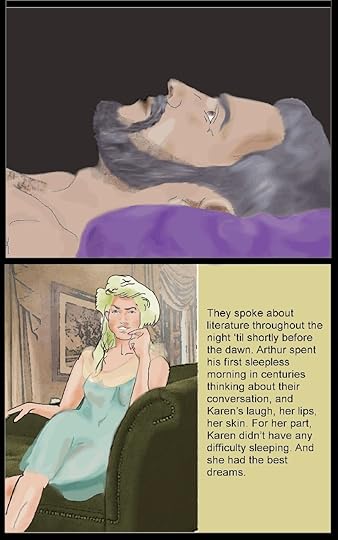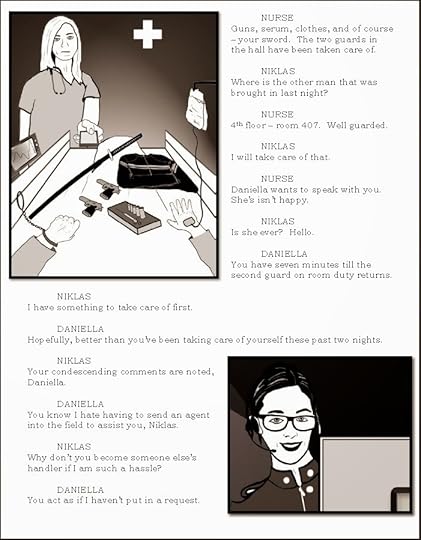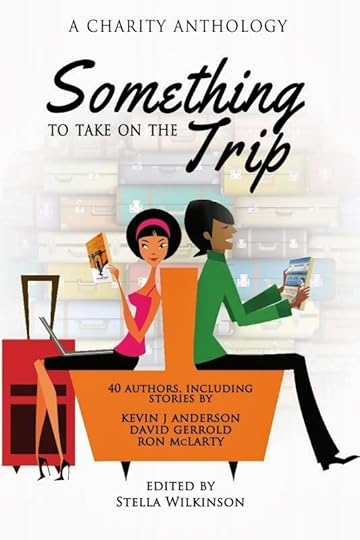J. David Core's Blog, page 21
May 20, 2014
Why Lupa Schwartz Hates Religion
 Religion and atheism are recurring themes in the Lupa Schwartz mysteries. I try to write counterpoint characters to represent the theistic viewpoint and the neutral attitude, but Lupa Schwartz’s anti-theism is at the heart of every Lupa Schwartz story. My stories are also pastiche of the Nero Wolfe series (and Sherlock Holmes) so like the series’ grandfather, Rex Stout, who once wrote an essay entitled Why Nero Wolfe Likes Orchids, I have decided to explain Schwartz’s adamant opposition to all things pious.
Religion and atheism are recurring themes in the Lupa Schwartz mysteries. I try to write counterpoint characters to represent the theistic viewpoint and the neutral attitude, but Lupa Schwartz’s anti-theism is at the heart of every Lupa Schwartz story. My stories are also pastiche of the Nero Wolfe series (and Sherlock Holmes) so like the series’ grandfather, Rex Stout, who once wrote an essay entitled Why Nero Wolfe Likes Orchids, I have decided to explain Schwartz’s adamant opposition to all things pious.Below the fold…
Published on May 20, 2014 21:21
May 6, 2014
An Update
I thought it was about time to post a status update on what I have been working on. It's been a month and a half since I published Believe It and two months since Common Sense. Book three in the Lupa Schwartz series, Fair Play, is about to go into the beta phase for editing, and hopefully it will be ready to roll out in four months or so.
In the meantime, I have been working on a project I conceived way back in the mid-90's – a graphic novel. I attended the Art Institute of Pittsburgh in the early 80's and always hoped to be a cartoonist. I wanted to be an editorial cartoonist for a newspaper more than anything, but the closest I ever got was working as a fill in cartoonist for Pitt University's student paper a few times. I also wrote for and illustrated for a humor magazine that was distributed free in the Pittsburgh area, and probably could have parlayed those credits into something bigger if I'd had the luxury of time to invest into that career path, but it was not to be.
Then a decade later I decided to focus on writing short stories. One was a story about King Arthur. I thought – if the Arthur myth says he will return to regain Camelot some day, doesn't hat mean he will be somehow undead? I wrote the idea up as a short story, but always thought it would work better as a graphic novel. I began doodling out an outline and sketching up some character ideas in my spare time, but I didn't have the time or money to invest in an art table and t-square, not to mention photo references, and how would I do tests? After all, nobody wants to go to a publisher on spec with a project that's "finished" but needs edits.
But today everything is different. Today there's GIMP and KDP. I have everything I need to complete this project right on my PC. So allow me to premier (in no particular order) a few working pages from The Return of the Dragon. Hopefully it will be ready for beta testing about the time that Fair Play goes to market. Enjoy.



In the meantime, I have been working on a project I conceived way back in the mid-90's – a graphic novel. I attended the Art Institute of Pittsburgh in the early 80's and always hoped to be a cartoonist. I wanted to be an editorial cartoonist for a newspaper more than anything, but the closest I ever got was working as a fill in cartoonist for Pitt University's student paper a few times. I also wrote for and illustrated for a humor magazine that was distributed free in the Pittsburgh area, and probably could have parlayed those credits into something bigger if I'd had the luxury of time to invest into that career path, but it was not to be.
Then a decade later I decided to focus on writing short stories. One was a story about King Arthur. I thought – if the Arthur myth says he will return to regain Camelot some day, doesn't hat mean he will be somehow undead? I wrote the idea up as a short story, but always thought it would work better as a graphic novel. I began doodling out an outline and sketching up some character ideas in my spare time, but I didn't have the time or money to invest in an art table and t-square, not to mention photo references, and how would I do tests? After all, nobody wants to go to a publisher on spec with a project that's "finished" but needs edits.
But today everything is different. Today there's GIMP and KDP. I have everything I need to complete this project right on my PC. So allow me to premier (in no particular order) a few working pages from The Return of the Dragon. Hopefully it will be ready for beta testing about the time that Fair Play goes to market. Enjoy.



Published on May 06, 2014 09:36
April 23, 2014
Book Review: The Spirit and the Shadow by Thomas P. Lavalle and Brandon L. Swope
 Brandon L. Swope
Brandon L. Swope
 Thomas P. LaValleDetective Robert Garrison is an investigator in the Vampire-Human division of the LAPD. He’s human. Detective Aiden Lawson is Garrison’s partner. He’s a vampire. Together they investigate any incident involving human-vampire violence – whether vamp on human or human on vamp in nature. When a human victim turns up in an alleyway with his throat half ripped out in an uncharacteristic attack, the two are pulled into a case that draws them into an international conspiracy involving assassination squads, covert operatives and a mysterious package.
Thomas P. LaValleDetective Robert Garrison is an investigator in the Vampire-Human division of the LAPD. He’s human. Detective Aiden Lawson is Garrison’s partner. He’s a vampire. Together they investigate any incident involving human-vampire violence – whether vamp on human or human on vamp in nature. When a human victim turns up in an alleyway with his throat half ripped out in an uncharacteristic attack, the two are pulled into a case that draws them into an international conspiracy involving assassination squads, covert operatives and a mysterious package.

The Spirit and the Shadow is Book One in a proposed series of graphic novels written by Thomas P. Lavalle and illustrated by Brandon L. Swope. Actually, it’s less a graphic novel and more a novella in script form with an ongoing story-board. There are no speech or thought balloons, no narrative paragraphs, and no consistent panel-for-panel visual arc. The illustrations use only two colors, black and red, and the red is not used sparingly. Storywise, The Spirit and the Shadow weaves a very clever vision which seems to have been conceived as a television series for Netflix or HBO. It’s just that violent and has some adult language, but it’s missing the requisite nudity that would assure it a second season on paid cable or subscription Net service. It has a well-developed and involved mythology which tows the line of the usual vampire tropes while tweaking the genre in some very original ways.
Illustratively, it’s a little amateurish. Stylistically, the drawings look like something which would have been submitted as concept art to a professional to be fleshed out; and many of the drawings are used repetitively – which comes across as lazy; although the artist does introduce some clever ideas into the mix. For example, in a few sequences, if the reader pages through the images quickly, there’s something of a flipbook animation gimmick which unexpectedly materializes.
The Spirit and the Shadow ends in a cliff hanger, which is probably intended to go several episodes if not establish an indefinite series. The concept and story are probably strong enough to support that aspiration. However, other than family and friends of the creative team, I don’t think a general audience will embrace the script format or the monotony of the repetitive images.
You can get all the info on their book at their website: thespiritandtheshadow.com.
Excerpt



Published on April 23, 2014 21:47
April 11, 2014
Book Review: Sons of Cain by C.W. Burgett
 Jack Basset is a reporter for a major daily with a particular talent for sniffing out good stories. His current assignment is to find out why an assassin murdered a US Senator a year before. Jack finagles a meeting with the prisoner (who refuses to meet or talk with anybody with the exception of one man) by having guards tell the prisoner that the one person he will meet with is waiting to see him. Jack leaves the meeting with precious little, and soon learns that the prisoner, the prison guard, and Jack’s editor have all been killed. Realizing that he’s probably next, Jack scurries to protect his family and self just as the assassination team arrives at his house.
Jack Basset is a reporter for a major daily with a particular talent for sniffing out good stories. His current assignment is to find out why an assassin murdered a US Senator a year before. Jack finagles a meeting with the prisoner (who refuses to meet or talk with anybody with the exception of one man) by having guards tell the prisoner that the one person he will meet with is waiting to see him. Jack leaves the meeting with precious little, and soon learns that the prisoner, the prison guard, and Jack’s editor have all been killed. Realizing that he’s probably next, Jack scurries to protect his family and self just as the assassination team arrives at his house.

Sons of Cain by C.W. Burgett is a thriller involving a secret society determined to advance to the white house. The writer goes out of his way to avoid strong language and sexual situations. Unfortunately that doesn’t always work to keep the reader engaged. In one particularly grating scene, a nurse who has been helping Jack attempts to seduce him only to have her advances rebuffed by the hero who wishes to remain faithful to his wife. The seduction is clumsy, ill-timed, and comes out of nowhere. It reads like the fantasy of a twelve year old boy, like the Heavy Metal seduction scene Kenny imagines in that one episode of South Park.
The novel opens strongly. The first chapter is particularly well written and fast paced. However, the rest of the book doesn’t live up to that opening chapter. In fact, the difference is so noticeable that it’s as if the writer gave the novel to a professional who edited the first chapter on spec and then quoted a price for the remainder which Burgett was unwilling to pay. For example, the writer has a habit of using proper names when a pronoun would have worked better. He also uses a simple vocabulary with three-dollar-words interjected pell-mell. (See what I did there?)
Burgett has obviously seen more thriller movies and learned their lessons than he has read thriller novels to learn theirs. Burgett’s desire to write uplifting Christian lit is also evident in the sparse narration. This is a story with a message when a story with a story would have been better. Actually, to be fair, the story itself is actually very well crafted and clever. It would make a decent TNT movie starring Lorenzo Lamas.
The book is available on Amazon, and has a Goodreadspresence. Mr. Burgett can be found on Facebook or on his own website.
Excerpt
Jack read the passage and looked up at Keith for an explanation. Keith smiled at Jack before responding to the unspoken question.
“Basically, it puts forth an alternative view of Cain. It says that when God made Cain into a nomad, he vowed that death would be his legacy. He spent the rest of his life pitting tribe against tribe and brother against brother. He taught his children to cause war as a means of gaining the spoils.
“It claims that almost every major war can be traced back to the group that Timothy belongs to--they call themselves The Sons of Cain. Alexander the Great, Napoleon, even Abraham Lincoln were all members of this organization.”
Jack flipped through the pages and found that what started merely as names, turned into signatures on the left and typed out names on the right. Jack could not help but stop and stare at one name in particular.
A few years back, Jack had written an article that had required reading of many of this man’s writings, thus becoming very familiar with the handwriting. There was no doubting it: the signature of Adolph Hitler.
“That night, I took the book home and read it. To me, it seemed extremely interesting--it sounded like a group of businessmen that had the foresight to prepare themselves to reap the benefits of war. Frankly, that sounded right up my alley. “At first, I didn’t believe all of the Cain stuff, but over time and research, I have concluded that it must be true. The next day I met with Tim again. After I told him I liked what I had read, he pulled out this book.”
Keith pulled another folder out of the bag. This one was similar to the first, but smaller.
Keith smiled and opened the folder to the first page without saying a word.
Published on April 11, 2014 09:37
March 20, 2014
Charity Book Anthology: Something to Take on the Trip
 Cover design by:
Cover design by:Gayle Ramage
www.gayleramage.co.ukThe third installment of the charity anthology which began with Something to Read on the Ride , continued through Something to Take on the Journey , and is now about to be completed with Something to Take on the Trip, is due to be released on April 1, 2014. All stories and work including editing services by Amy K. Maddox of The Blue Pencil as well as each of the three original covers were donated free of charge and all proceeds benefit the Grand Appeal for Wallace & Gromit's Children's Charity which helps children in hospital in the UK. I personally have stories in the first and third installments. The collection is the brainchild of Stella Wilkinson who personally selected all of the stories for inclusion.
Published on March 20, 2014 10:54
March 4, 2014
Book Trailer for Believe It, You Know an Atheist

Excerpt
Introduction
You’re probably a Christian, but you might also be Jewish, or Muslim, or Hindu, and you bought or were given this book because you know somebody who is an atheist and you either are or somebody expects that you are having or are going to have a hard time accepting it. The purpose of this book is to help you to understand what atheism is and is not. This is not an attempt to indoctrinate you into atheism or to make you question your faith; however, I will defend the atheist’s right to be an atheist, so it’s possible, therefore, that at some point(s) in this discussion you will find I challenge long-held beliefs.If at some point while reading, you find yourself angered or if you begin to simply dismiss difficult concepts or arguments just because they make you uncomfortable, that’s not my fault. Your faith is either strong enough to stand up to scrutiny, or it is not. If it is, that’s great. You’re a theist. We knew that coming in. If not … if you begin doubting your convictions and struggling with your desire to maintain beliefs that no longer fit you, that’s okay too. That’s probably similar to what happened to the atheist you know.I’m going to tell you a little bit about who I am and why I am writing this book. Then I am going to tell you a little bit about how this book is structured. I’m providing this information now to prepare you for the experience of evaluating what—for some—might be a challenging read. Not challenging because of the language and not challenging because it’s over your head, but challenging because it deals with subject matter you long ago decided was a fixed part of your worldview, and now somebody you care about is challenging that worldview.You’re probably wondering what qualifies me to write this book. Am I a lapsed theologian, a philosophy PhD, the appointed spokesman of the Church of Atheism? No, I’m just a guy who used to believe in God, had a crisis of faith at a young age, came out to my family as a non-believer, and grew up in a country where my beliefs (or lack thereof) are marginalized and in many cases scorned outright. My educational background is in communications, and I have written professionally for years, including working as a news writer for the YouTube channel AtheismTV’s news broadcast, The Infidel. You may be thinking this means you can take my opinion with a grain of salt since I rejected belief and cannot appreciate the experience of faith. I’ll cover that a little deeper later in the book, but for now, let me assure you—that opinion is not supported by the facts.I was raised in a Catholic home by Catholic parents who had me baptized and confirmed. We attended mass weekly, and I underwent eight years of CCD classes (basically Catholic Sunday School.) Nothing “bad” ever happened to me in the Catholic Church. In fact, growing up I wanted to be a priest for a while. My first wife was a member of the Church of Christ, and we attended church together frequently, even though by this time I was an out and proud atheist. My second wife was a Methodist and we were married in the Methodist Church, although we never attended. (I encouraged her to attend services and to take our daughter if she wished, and even offered to attend with her. She remains a nominal Christian to this day.) I am currently in a relationship with a woman who considers herself a social Mormon. She’s very spiritual and believes in ghosts. I have friends who practice Reiki and go on ghost hunting adventures. Another friend is a minister in the Nazarene Church. I have rung bell for the Salvation Army (although I stopped because of their anti-gay policies.) One of my cousins is an evangelical, and whenever we meet, we respectfully discuss whatever apologetic meme Ray Comfort or Rick Warren introduced to his minister that month.The bottom line is I don’t hate religion or God or the religious. I’m actually fascinated by the topic and know it pretty well. I respect my religious friends and they respect me.Now for a little about this book: I have divided it into three parts. The first part is the basic layout of what atheism is and is not and why a person might come to it. It’s the meat-and-potatoes of why you have this book to begin with. If you read only the first part and then quit, you’ll have a better understanding of your atheist relative or friend.The second part is for those of you who want to better understand how a person comes to reject the God hypothesis (as Carl Sagan called it.) Note that I did not say “how a person comes to reject God.” Atheists do not reject God; atheists do not believe in God. The two concepts are not interchangeable. For example: you may believe in fairies; but if I don’t, that does not mean I reject fairies. But we are getting ahead of ourselves—more on that later.The third part is a deeper defense of atheism itself. It explores the harder philosophical issues and the more deeply ingrained social/religious norms. If you choose to read it, expect to have your beliefs questioned. Read the second part if you want an idea of how your atheist associate possibly thinks, and read the third part if you want to know how he or she could feel confident in his or her decision.In reading this introduction, you may have noticed I wrote it assuming as little as possible about the reader and the person he or she is reading for. That’s about to change. For purposes of clarity, I am going to make certain assumptions about the reader and the reader’s atheist. I realize this opens me up to accusations of straw manning, but it’s necessary so the narrative doesn’t bog down in “he/she” slashes and “Christian, Muslim, Jew, Hindu …” mini-lists. From now on, except where otherwise indicated, I am writing to an American Protestant mother who has just learned that her son is an atheist. Odds are, that’s you. If not, I have every confidence you can make the adjustments.
Part One – Understanding the Fundamentals
Typically, the older we become, the more ingrained our worldview becomes. Conversely, the younger we are, the easier it is to accept new (and foreign) knowledge and adapt to it. Consider that babies learn language much easier than adults, and young people adapt much more easily to changes in their situations. Yet, as we age, it becomes harder to learn languages or to acclimate to environmental upheaval. A baby with absolutely no foreknowledge will learn to passably speak the language of her parents with no formal education or training at all. A six year old will quickly adjust to a move from the Deep South to the Snow Belt … or from the US to Dubai for that matter.However, as adults, many will not only find diphthongs, umlauts and gender-based articles confusing, they will probably consider them to be just wrong. Meanwhile, the culture shock some experience on vacation in Europe or Asia can be enough to make them so uncomfortable that the idea of moving there permanently would actually cause heart palpitations.Yet people of all ages do move to Europe and Asia all the time. Each and every day, adults learn to speak languages with rules that seem to make no sense. There are socially accepted reasons for this to happen, so nobody tends to question why one would make such a drastic change to the status quo. However, changing one’s long-held ideas about the nature of existence is another matter. If you think about it, what one believes about the nature of the universe isn’t automatically right just because a person believes it. Many people believe a number of discordant things about such topics as creation, death, eternity, afterlife, etc. Clearly some of those beliefs are incorrect, and obviously those who believe “A” do not think that you are the one with the right answer if you believe “B.”If you are a Christian, you do not think the prophet Mohammad was the emissary of God. If you were Muslim, you would not believe that Jesus was divine. The tenets of the other religion would be, in your opinion, something to reject. You would be, in effect, an atheist toward that religion. Here’s a hard fact: in regards to your beliefs, most people in the world are atheistic towards what you believe, and you are atheistic in regard to most of the world’s beliefs.This is known as Roberts’ Rule. First articulated by an atheist named Stephen Roberts, the rule says simply, “I contend that we are both atheists. I just believe in one fewer god than you do. When you understand why you dismiss all the other possible gods, you will understand why I dismiss yours.”In other words, asking an atheist why he doesn’t believe in God is like asking you why you don’t believe the prophet Mohammad was delivering God’s message. A person believes what he believes, and disbelieves what he cannot believe. In that sense, atheism is not a decision one makes, but a realization one comes to about one’s self.Try to make yourself believe something you simply don’t believe. Yes, it can be done, but not under normal conditions. Stockholm Syndrome, for example, is a legitimate psychological phenomenon in which a person under duress from a captor begins to empathize with his oppressor. However, not every example of belief by indoctrination is so severe. Through meditation you can convince yourself that you are not feeling pain or that a red barn is blue. However, if your son tells you that he is the one who believes the barn is blue, he’s not going to simply stop believing it just because you make a compelling argument that it’s actually red. Also, his refusal to acknowledge the redness of the barn—while a rejection of your interpretation—is not a rejection of you as a person.This is one way you can begin to understand his atheism. It’s not a rejection of you or of your love. Somewhere in your family history, your ancestors converted to Christianity—rejecting the faith of their forebears. This doesn’t mean that your great-great-great-great-grandmother didn’t love her mother and father. It means she made her own decision for her own life, and she was brave to do so.Keep this in the front of your mind as you continue to read. Your son just came out as an atheist, but he didn’t just become one yesterday. It’s been a process, and he has thought about it. He was an atheist yesterday, and he loved you then, and you loved him. The only thing that’s changed is you now know something about him that you didn’t know yesterday but was true yesterday nonetheless. It’s no different than the time you learned that he doesn’t care for your eggplant casserole.A word of caution: many theists (people who believe in God) approach discussions with atheists disingenuously. A well-known theistic vlogger known as shockofgodinvented a term he calls “Santa Syndrome.” Whenever an atheist compares coming to the realization that he does not believe in God to when he realized there was no Santa, Shock derisively dismisses the argument as sour grapes. In doing so, he ignores the underlying point the atheist is making which denies Shock of the possibility to engage on an honest level. Please do not make that mistake as you read on.
Published on March 04, 2014 17:30
March 1, 2014
Guest Post: The Future of Publishing by Jordan Smith
If you have an ereader, and like to relax and read a little before going to sleep, you may not realize that what you’re doing not too long ago would’ve seemed like it was from Science Fiction. Many things we used to regard that way creep into our world, almost imperceptibly, and pretty soon we can’t imagine modern life without them. The world of books and publishing is one area where this has happened quite significantly.

At the big picture level, take the 1931 Herman Hesse novel The Glass Bead Game. This highly regarded Sci Fi story set hundreds of years from now involves an intellectual order of people who play an irreducibly complex game that many have said is analogous to our hyper-connected digital world. To quote Bruce Milligan, Director of New Media at the AOL subsidiary Redgate, the ‘game’ of this book’s title comes to his mind when he thinks about what the internet is now: ‘a realm of pure intellect, minds interacting with machines, constructs of information designed to facilitate the sometimes-ordered, sometimes-random and often serendipitous roamings of human inquisitiveness.’
How strange it might be for Hesse if he were alive today to see that something so close to what he imagined is one of the central parts of life in the developed world now. It reminds us all that to a complete outsider who would look on our internet now it would seem strangely abstract. So much of the web is only about ideas and information, humor or audio-visual experience. This is wonderful in some ways, but also odd in just how removed from actual experience so much of our online world is. The online world facilitates many real world things. I myself am in a relationship with a woman I met online. But on the web now we use terms like IRL (in real life) to refer to such things that actually exist outside of the internet. It’s often otherwise assumed that what we refer to online does not.
Now look at ereaders themselves. I remember watching the Star Trek series’ of the 1990s and marveling at how the characters could pick up a small digital device and use it to peruse a great deal of information. Say, as much or more information than could be packed into a standard sized book. ‘Just imagine that!’ I thought, how far off and distant from my time that must be! The original Star Trek series in the 1960s conveyed a similar technology, and at that time when computers were the size of buildings, and understood mostly by sophisticated academics, such an idea must have seemed utterly fantastical.
But when you really think about it ereaders actually aren’t that shocking, at least in a way. Not long into the history of the computer it was realized that the amount information that could be stored on them would become exponentially more efficient over time thanks to principles like Moore’s law. As decades have progressed it would only make sense that some threshold would be crossed where they could store as much information as books. That point was actually reached back in the 1990s. In the 90s Steve Jobs, and before him Nicholas Negroponte in the 80s, were actually predicting the rise of mobile tablet devices that you control with your fingers. Once there exists commercially feasible small computers and commercially feasible computer screens you can use your fingers to interface with, the combination of the two to create things like the Kindle and Ipad would inevitably catch on.
So if you followed these trends you actually could have foreseen the rise of eBooks. But eBooks are still a quantum leap in functional possibilities over ink and paper books. eBooks can be networked, the content hidden or displayed an infinite number of times. Vast amounts of new content can be brought to an ereader in minutes online. This raises, quite suddenly, many advantages and problems we didn’t have to think about a short while ago. While eBooks allow a lot of access to books, do they not also cheapen what a book is? How will anyone use a book to escape when the device you read it on is connected to so much of the world?
Focusing on the functional difference between traditional books and digital ones, you can see what a departure from the recent past they are. Herman Hesse may have foreseen that a world of deep informational interconnection was coming because radio and wire services were increasing the connectedness of people in his time, and the technology enabling that was already fast-evolving back then. But to many who hadn’t thought as much about those things, the idea that we can all maintain so many different connections to so many far flung people and institutions would seem like a quantum leap as well.
There’s good news here for people such as myself; I’m an aspiring Sci Fi author and blogger who wishes to put my content out into the world. Content creators are the winners in our brave new world; access to content may be cheap now and most reading done on networked devices, but that has fundamentally eroded barriers to content distribution, and made end runs around the content gatekeepers the new norm.
I’ve written one Sci Fi novel that I plan to release on Kindle soon where I touched on a new technology that could also change the world of writing and publishing; today when authors compose books we type the words, or maybe speak them to a voice recognition system. Pretty soon what if we think our words directly onto the digital page? But that’s so far off right? How can we imagine a computer that you can interact with using only your brain? I don’t know, but a brilliant woman named Tan Le has actually been working on it for years.
###
Jordan's website is at jordanthomassmith.com if you care for more musings

At the big picture level, take the 1931 Herman Hesse novel The Glass Bead Game. This highly regarded Sci Fi story set hundreds of years from now involves an intellectual order of people who play an irreducibly complex game that many have said is analogous to our hyper-connected digital world. To quote Bruce Milligan, Director of New Media at the AOL subsidiary Redgate, the ‘game’ of this book’s title comes to his mind when he thinks about what the internet is now: ‘a realm of pure intellect, minds interacting with machines, constructs of information designed to facilitate the sometimes-ordered, sometimes-random and often serendipitous roamings of human inquisitiveness.’
How strange it might be for Hesse if he were alive today to see that something so close to what he imagined is one of the central parts of life in the developed world now. It reminds us all that to a complete outsider who would look on our internet now it would seem strangely abstract. So much of the web is only about ideas and information, humor or audio-visual experience. This is wonderful in some ways, but also odd in just how removed from actual experience so much of our online world is. The online world facilitates many real world things. I myself am in a relationship with a woman I met online. But on the web now we use terms like IRL (in real life) to refer to such things that actually exist outside of the internet. It’s often otherwise assumed that what we refer to online does not.
Now look at ereaders themselves. I remember watching the Star Trek series’ of the 1990s and marveling at how the characters could pick up a small digital device and use it to peruse a great deal of information. Say, as much or more information than could be packed into a standard sized book. ‘Just imagine that!’ I thought, how far off and distant from my time that must be! The original Star Trek series in the 1960s conveyed a similar technology, and at that time when computers were the size of buildings, and understood mostly by sophisticated academics, such an idea must have seemed utterly fantastical.
But when you really think about it ereaders actually aren’t that shocking, at least in a way. Not long into the history of the computer it was realized that the amount information that could be stored on them would become exponentially more efficient over time thanks to principles like Moore’s law. As decades have progressed it would only make sense that some threshold would be crossed where they could store as much information as books. That point was actually reached back in the 1990s. In the 90s Steve Jobs, and before him Nicholas Negroponte in the 80s, were actually predicting the rise of mobile tablet devices that you control with your fingers. Once there exists commercially feasible small computers and commercially feasible computer screens you can use your fingers to interface with, the combination of the two to create things like the Kindle and Ipad would inevitably catch on.
So if you followed these trends you actually could have foreseen the rise of eBooks. But eBooks are still a quantum leap in functional possibilities over ink and paper books. eBooks can be networked, the content hidden or displayed an infinite number of times. Vast amounts of new content can be brought to an ereader in minutes online. This raises, quite suddenly, many advantages and problems we didn’t have to think about a short while ago. While eBooks allow a lot of access to books, do they not also cheapen what a book is? How will anyone use a book to escape when the device you read it on is connected to so much of the world?
Focusing on the functional difference between traditional books and digital ones, you can see what a departure from the recent past they are. Herman Hesse may have foreseen that a world of deep informational interconnection was coming because radio and wire services were increasing the connectedness of people in his time, and the technology enabling that was already fast-evolving back then. But to many who hadn’t thought as much about those things, the idea that we can all maintain so many different connections to so many far flung people and institutions would seem like a quantum leap as well.
There’s good news here for people such as myself; I’m an aspiring Sci Fi author and blogger who wishes to put my content out into the world. Content creators are the winners in our brave new world; access to content may be cheap now and most reading done on networked devices, but that has fundamentally eroded barriers to content distribution, and made end runs around the content gatekeepers the new norm.
I’ve written one Sci Fi novel that I plan to release on Kindle soon where I touched on a new technology that could also change the world of writing and publishing; today when authors compose books we type the words, or maybe speak them to a voice recognition system. Pretty soon what if we think our words directly onto the digital page? But that’s so far off right? How can we imagine a computer that you can interact with using only your brain? I don’t know, but a brilliant woman named Tan Le has actually been working on it for years.
###
Jordan's website is at jordanthomassmith.com if you care for more musings
Published on March 01, 2014 08:58
February 15, 2014
Two Books in Two Weeks!
This is an exciting time for me as a self-publishing author. The second book in my mystery novel series, Common Sense, is about to be released in paperback and eBook at the end of this month, and then on St. Patrick’s Day, March 17, 2014, I will be releasing my very first non-fiction book, Believe It, You Know an Atheist. Here’s the blurb and cover reveal for that book.
How can you find common ground when a loved one no longer believes in God?
Cover design by Yocla Designs
Without ever insisting that atheism is the correct conclusion, Believe It strives to bridge the disconnect between the devout and the debunkers. Featuring quotes and arguments found throughout the history of skepticism from Epicurus to Sam Harris and beyond, Believe It lays out a line of reasoning and analysis designed to illuminate the thinking that inspires a godless worldview. Broken down into three parts, J. David Core here examines from an atheist's POV the fundamentals of disbelief; likely refutations of some of the more common theistic arguments; and such difficult issues as grace, the historicity of religious texts, and the nature of truth.
Whether you are the parent of a new atheist, a co-worker of a long-time unbeliever, or simply want to understand the motives and thought processes of your non-religious friends, Believe It: You Know an Atheist.
Published on February 15, 2014 11:22
February 6, 2014
Book Review: The Hacktivist by R.J. Webster
Jack Bishop is a young and impressive computer programmer fresh out of college and deeply in love with his medical doctor girlfriend, Catherine. He’d known for some time that the day would come when she would set off on her life’s dream to help the poorest of the poor, but when she boards that plane bound for Haiti leaving him behind to await her return, it leaves him feeling more than alone. It leaves him feeling empty. He desperately wants to find some way that he too can help, but how is a computer programmer – even one as talented and devoted as Jack – supposed to benefit the starving and sick poor?
 Then one day the company’s security team approaches him about a programming problem and Jack becomes obsessed with learning everything he can about Trojans, and viruses, and IRC server channels. Partly he’s obsessed to fill the void Catherine left in his life, but soon the seed of a plan begins to germinate. Jack can use his new-found knowledge to build his own code – a code to help the charities that help in places like Haiti.
Then one day the company’s security team approaches him about a programming problem and Jack becomes obsessed with learning everything he can about Trojans, and viruses, and IRC server channels. Partly he’s obsessed to fill the void Catherine left in his life, but soon the seed of a plan begins to germinate. Jack can use his new-found knowledge to build his own code – a code to help the charities that help in places like Haiti.
Part techno-drama, part instruction manual, The Hacktivist by R.J. Webster is a book with three agendas; entertain with a realistic cyber-crime story, educate the reader about the legitimate risks of surfing the web in today’s hacker-rich environment, and maybe –just maybe – inspire some people to throw a little scratch at such worthwhile charities as Doctors Without Borders and justgive.org.
As an instruction manual, it succeeds very well. The premises are complicated and highly math-based, but Webster explains the concepts in ways which are very accessible. As a techno-thriller it falls just a little flat. There are few real episodes of high tension or perceived danger. The characters are all believable but just a little one-note. Even the relationship between the counter-hero protagonist and his lady love is mostly seen in rough sketches and long distance emails. There are also a number of walk-on characters who are clearly there only to advance the tech-manual aspect, but they all seem to speak in the same voice using the same kinds of accessible verbal shorthand. Additionally, a few side stories are introduced but don’t really go anywhere. In one episode, a Paris Hilton/Kim Kardashian-type celebrity is victimized by an early iteration of the virus, and vows to go on an O.J.-like quest for the “real” hacker, but nothing ever comes of it. Hints are dropped throughout the story that Jack’s dog, Argus, will somehow trip up Jack’s well-laid plans, but again, that plotline just sort of peters out.
The story also might have benefited from a few more true-life examples of Haitian suffering if the author really wanted to compel casual readers to action. A few asides into Catherine’s and her peers’ day-to-day lives might have accomplished that and added some genuine depth to her character. There are clever flashes through the story, however. A very clever example which I really enjoyed involves an FBI agent who could use the PATRIOT Act to great advantage but decides to be a person instead. I don’t usually rate the stories I review, but in this case, I’m giving The Hacktivist an “A” as a learning tool, a “B” on the Sarah McLaughlin-style PSA, and a “C++” for the story and characters.
10% of the proceeds from this book will go to Partners in Health to help the poor in Haiti. The Hacktivist is available on Amazon for the Kindle.
 Then one day the company’s security team approaches him about a programming problem and Jack becomes obsessed with learning everything he can about Trojans, and viruses, and IRC server channels. Partly he’s obsessed to fill the void Catherine left in his life, but soon the seed of a plan begins to germinate. Jack can use his new-found knowledge to build his own code – a code to help the charities that help in places like Haiti.
Then one day the company’s security team approaches him about a programming problem and Jack becomes obsessed with learning everything he can about Trojans, and viruses, and IRC server channels. Partly he’s obsessed to fill the void Catherine left in his life, but soon the seed of a plan begins to germinate. Jack can use his new-found knowledge to build his own code – a code to help the charities that help in places like Haiti. Part techno-drama, part instruction manual, The Hacktivist by R.J. Webster is a book with three agendas; entertain with a realistic cyber-crime story, educate the reader about the legitimate risks of surfing the web in today’s hacker-rich environment, and maybe –just maybe – inspire some people to throw a little scratch at such worthwhile charities as Doctors Without Borders and justgive.org.
As an instruction manual, it succeeds very well. The premises are complicated and highly math-based, but Webster explains the concepts in ways which are very accessible. As a techno-thriller it falls just a little flat. There are few real episodes of high tension or perceived danger. The characters are all believable but just a little one-note. Even the relationship between the counter-hero protagonist and his lady love is mostly seen in rough sketches and long distance emails. There are also a number of walk-on characters who are clearly there only to advance the tech-manual aspect, but they all seem to speak in the same voice using the same kinds of accessible verbal shorthand. Additionally, a few side stories are introduced but don’t really go anywhere. In one episode, a Paris Hilton/Kim Kardashian-type celebrity is victimized by an early iteration of the virus, and vows to go on an O.J.-like quest for the “real” hacker, but nothing ever comes of it. Hints are dropped throughout the story that Jack’s dog, Argus, will somehow trip up Jack’s well-laid plans, but again, that plotline just sort of peters out.
The story also might have benefited from a few more true-life examples of Haitian suffering if the author really wanted to compel casual readers to action. A few asides into Catherine’s and her peers’ day-to-day lives might have accomplished that and added some genuine depth to her character. There are clever flashes through the story, however. A very clever example which I really enjoyed involves an FBI agent who could use the PATRIOT Act to great advantage but decides to be a person instead. I don’t usually rate the stories I review, but in this case, I’m giving The Hacktivist an “A” as a learning tool, a “B” on the Sarah McLaughlin-style PSA, and a “C++” for the story and characters.
10% of the proceeds from this book will go to Partners in Health to help the poor in Haiti. The Hacktivist is available on Amazon for the Kindle.
Excerpt
Steve turned to John and explained, “Scheuerman’s been doing the dynamic reverse engineering of the bot and has been watching the most recent command and control server for us. You probably want to hear this too.” John waved Scheuerman in, “What have you got?” “Well, the C server sent out an update command, a major update. That is pretty normal, we were seeing updates about once every week or two for a while and then it went quiet for a few weeks and now this. The update command told the bot client to go to a website we have not seen used before. It then downloaded an executable file from there and ran it. As you know, we have one infected system that we are letting just do its thing so it went ahead and updated itself. Well after the update we watched it closely but it did nothing that we could detect. Nothing at all happened. It has stopped trying to communicate. It dropped out of the Command and Control server. The normal behavior was that it would stay connected to the chat room waiting for a command from the C. After this last update completed, it closed the connection and went silent. We have been watching it for over 24 hours now and it has done nothing at all.” John asked, “Did it shut itself down, or is the viral process still running on the computer?” Scheuerman told them that it was still running that they could still see the process running though it took quite a bit of effort. The rootkit made it difficult to detect this particular process by normal means. John turned to Steve, “Well what do you think, could it be laying low because it knows we’re watching somehow? We’ve seen that before, some logic that can detect a lab environment. Or do you think it might have a new way to communicate, maybe periodically instead of an up all the time connection?” They had all seen viruses that refused to run when in a monitored environment. There were tricks that viruses used to detect if they were running in a virtual environment or in a debug environment. Some viruses were simply smart enough to detect when they were running in the kind of testing environment that the police used to unravel a virus’s mysteries. When they found they were in such an environment, they would simply shut down or refrain from functioning. It was more and more common for a virus to check first to see if the coast was clear before running. And many debug environments are easy to detect. A debug program is a tool that can run another program inside of itself, controlling how it runs. It can allow an engineer to run a program, a virus in this case, one precise machine code command at a time if necessary, stepping through the program with incredible slowness in order to learn all the things that the malware might be capable of doing. Consider that CPU speeds are often measured in millions of instructions per second, MIPS, and with a debugger you can do them one at a time. Debugging a normal program wasn’t too hard if you understood machine code. Computer programs frequently make decisions from a set of available choices. They decide what they want to do next. The code might check its data and then choose a branch of code based on the data it sees. Some branches might never run if they don’t see the required data. When a program is run in a debugger by someone like Scheuerman, the investigator can force it to try every possible branch of execution to see all the possible things it might be capable of doing. The engineer can change the code of the program too. He can force data or commands into the program, he can basically lie to the program to force it to take each branch. But viruses these days are almost always encrypted in some way. They contained dummy logic and false paths of execution that led nowhere. Modern encrypted viruses might have lots of reverse engineering protections. They are often packed, that is compressed in some way, obfuscated and then encrypted. They only unencrypt themselves a little at a time. Often the only thing the investigator can see at first is a little bit of code in the beginning of the program which might contain jumps to seemingly random places in the virus file. Eventually, this jumping around process executes code to try to detect if it is being run in a lab. If the coast is clear, the virus can decrypt more of itself to memory and see if it is capable of running normally. If it is not, it leaves what’s left of its code encrypted and shuts down. Steve’s technical guys sometimes spent days removing protections or trying to understand the logic of obfuscated programs and then even more time trying to figure out how to decrypt them or convince them to decrypt themselves. What was worse no one wanted to do this kind of work forever so usually by the time someone got really good at it they wanted to move on to something else.
Published on February 06, 2014 19:53
January 26, 2014
Author Interview: Yoram Katz, Author of The Kabbalist
 I was recently approached by new author Yoram Katz about his historical thriller, The Kabbalist, which he describes as "a thoroughly researched historical detective/mystery novel, which spans 2,000 years of history, and puts the mystical doctrine of Kabbalah (which everybody talks about, but most really have no clue what it is...) in a new perspective." We conducted an interview via email.
I was recently approached by new author Yoram Katz about his historical thriller, The Kabbalist, which he describes as "a thoroughly researched historical detective/mystery novel, which spans 2,000 years of history, and puts the mystical doctrine of Kabbalah (which everybody talks about, but most really have no clue what it is...) in a new perspective." We conducted an interview via email.Please tell us a little about you and your book.As most Israelis do, I served the 3-year mandatory service, and participated in a war or two.I then studied Philosophy and Psychology at the Hebrew University in Jerusalem. I was so impressed, that having completed my BA in both, I immediately ran away to spend two years in Europe and Africa and then landed back on earth to study for my BSc. in Computer Engineering.Most of my career since has been spent in the flourishing Israeli hi-tech industry, where I held some senior managerial positions and travelled the globe. My career sent me for a few years to Singapore where I relocated with my wife and three children.I have always been an avid reader planned to find the time to write my own novels. With three children at home and an intensive career, the time for this never materialized, until, a few years back, I realized I could use the time made available for me during my trips. It felt right. The Kabbalist is my first published novel. I am now working on the next.
Tell me about your favorite scene in your novel. There are a few scenes I like but I would rather talk about an early scene in order to avoid a spoiler.
 There is this scene about a Jewish refugee running away from crusader Acre after it had fallen to the Muslims in 1291. He somehow managed to escape the crumbling city by sea, but now he is fighting for his life after his ship has capsized. He is terrified, but what happens to him next at sea is totally unexpected, changes his fortune – and lays a foundation for the rest of this multi-layered plot. It is an introduction to other twists the reader can expect in the story.
There is this scene about a Jewish refugee running away from crusader Acre after it had fallen to the Muslims in 1291. He somehow managed to escape the crumbling city by sea, but now he is fighting for his life after his ship has capsized. He is terrified, but what happens to him next at sea is totally unexpected, changes his fortune – and lays a foundation for the rest of this multi-layered plot. It is an introduction to other twists the reader can expect in the story.Can you tell us a little about your writing philosophy?What I expect a good book to provide me:1. Escape - keep me absorbed in the subject and plot2. Entertainment – enjoy the experience3. Enlightenment – I want it to teach me something new, give me an insight I did not have, or introduce me to new ideas. I would it to leave something with me after I have finished reading it.Some people are OK with having 1 & 2. I need all three to be satisfied. That’s what I want my books to be like.
Have you ever tried writing in any other genres? I have not published other novels so far. I am very fond of history, but I do not see myself necessarily tied to historical fiction. My next novel was inspired by a three-year stay in Singapore and my impressions of role spirits play in the Chinese day-to-day life.
Do you have any interesting writing-related anecdotes we can freewheel riff on? If so, can you explain it briefly? This novel is based on a “conspiracy” historical theory. It happened to me at least twice that I decided to take it in a certain direction and then found that this “new” direction had been actually brought up before by other scholars.
Yoram’s book is available at Amazon in both paperback and eBook. A trailer can be viewed on Youtube. The book also has a presence on Goodreads.
Published on January 26, 2014 22:22



